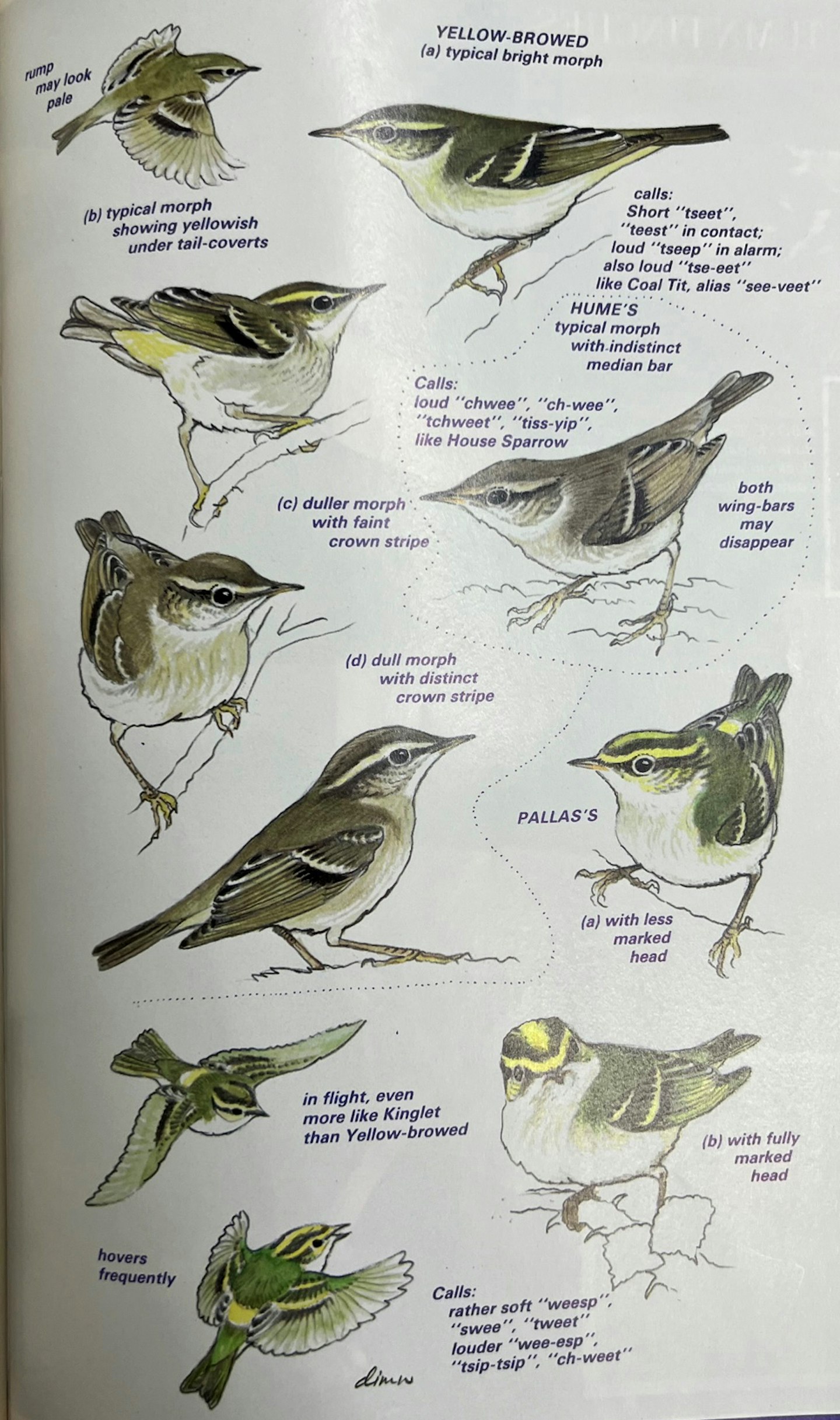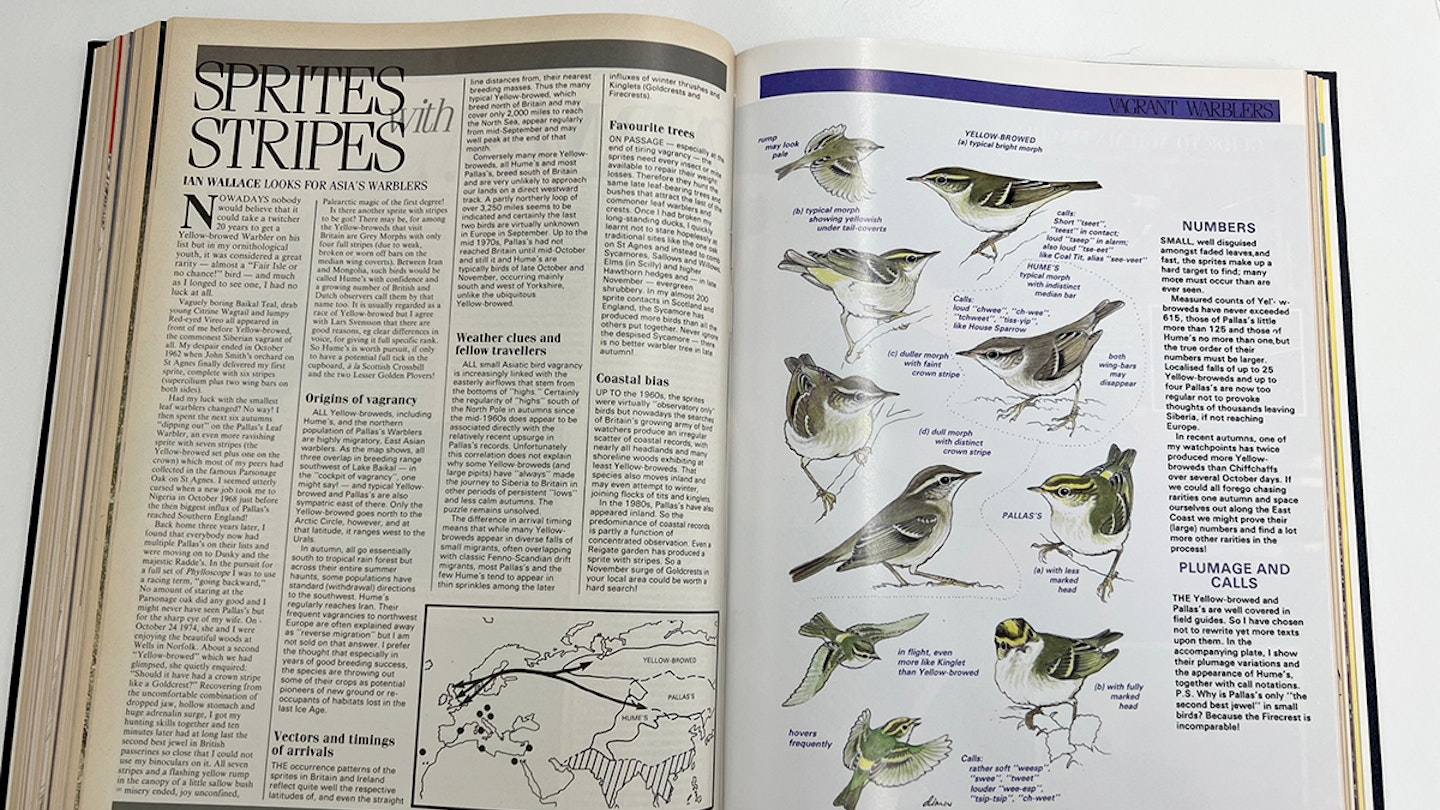Sprites with stripes
October 1987
Ian Wallace looks for Asia’s warblers
Nowadays nobody could take a twitcher 20 years to get a Yellow-browed Warbler on his list but in my ornithological youth, it was considered a great rarity - almost a ’Fair Isle or no chance!' bird - and much as I longed to see one, I had no luck at all.
Vaguely boring Baikal Teal, drab young Citrine Wagtail and lumpy Red-eyed Vireo all appeared in front of me, before Yellow-browed, the commonest Siberian vagrant of all. My despair ended in October 1962 when John Smith's orchard on St Agnes finally delivered my first sprite, complete with six stripes (supercilium plus two wing bars on both sides).
Had my luck with the smallest leaf warblers changed? No way! I then spent the next six autumns ‘dipping out’ on the Pallas's Leaf Warbler, an even more ravishing sprite with seven stripes (the Yellow-browed set plus one on the crown) which most of my peers had collected in the famous Parsonage Oak on St Agnes. I seemed utterly cursed when a new job took me to Nigeria in October 1968 just before the then biggest influx of Pallas's reached Southern England!
Back home three years later, I found that everybody now had multiple Pallas's on their lists and were moving on to Dusky and the majestic Radde's. In the pursuit for a full set of Phylloscopus warblers I was to use a racing term, ‘going backward’. No amount of staring at the parsonage oak did any good and I might never have seen Pallas's but for the sharp eye of my wife. On 24 October 1974, she and I were enjoying the beautiful woods at Wells in Norfolk. About a second ‘Yellow-browed’ which we had glimpsed, she quietly enquired: “Should it have had a crown stripe like a Goldcrest?” Recovering from the uncomfortable combination of dropped jaw, hollow stomach and huge adrenalin surge, I got my hunting skills together and ten minutes later had at long last the second best jewel in British passerines so close that I could not use my binoculars on it. All seven stripes and a flashing yellow rump in the canopy of a little sallow bush misery ended, joy unconfined, Palearctic magic of the first degree!
Is there another sprite with stripes to be got? There may be, for among the Yellow-broweds that visit Britain are Grey Morphs with only four full stripes (due to weak, broken or worn off bars on the median wing coverts). Between Iran and Mongolia, such birds would be called Hume' 's with confidence and a growing number of British and Dutch observers call them by that name too. It is usually regarded as a race of Yellow-browed but I agree with Lars Svensson that there are good reasons, eg clear differences in voice, for giving it full specific rank So Hume's is worth pursuit, if only to have a potential full tick in the cupboard, à la Scottish Crossbill and the two Lesser Golden Plovers!
Origins of vagrancy
All Yellow-broweds, including Hume's, and the northern population of Pallas's Warblers are highly migratory, East Asian warblers. As the map shows, all three overlap in breeding range southwest of Lake Baikal in the ‘cockpit of vagrancy’. one might say! - and typical Yellow- browed and Pallas's are also sympatric east of there. Only the Yellow-browed goes north to the Arctic Circle, however, and at that latitude, it ranges west to the Urals.
In autumn, all go essentially south to tropical rain forest but across their entire summer haunts, some populations have standard (withdrawal) directions to the southwest. Hume' regularly reaches Iran. Their frequent vagrancies to northwest Europe are often explained away as reverse migration but lam not sold on that answer. I prefer the thought that especially in years of good breeding success, the species are throwing out some of their crops as potential pioneers of new ground or re- occupants of habitats lost in the last Ice Age.
Vectors and timings of arrivals
The occurrence patterns of the sprites in Britain and Ireland reflect quite well the respective latitudes of, and even the straight line distances from, their nearest breeding masses. Thus the many typical Yellow-browed, which breed north of Britain and may cover only 2,000 miles to reach the North Sea, appear regularly from mid-September and may well peak at the end of that month.
Conversely many more Yellow-broweds, all Hume's and most Pallas's, breed south of Britain and are very unlikely to approach our lands on a direct westward track. A partly northerly loop of over 3,250 miles seems to be indicated and certainly the last two birds are virtually unknown in Europe in September. Up to the mid 1970s, Pallas's had not reached Britain until mid-October and still it and Hume's are typically birds of late October and November, occurring mainly south and west of Yorkshire, unlike the ubiquitous Yellow-browed.
Weather clues and fellow travellers
All small Asiatic bird vagrancy is increasingly linked with the easterly airflows that stem from the bottoms of ‘highs Certainly the regularity of ‘highs south of the North Pole in autumns since the mid-1960s does appear to be associated directly with the relatively recent upsurge in Pallas's records. Unfortunately this correlation does not explain why some Yellow-broweds (and large pipits) have ‘always made the journey to Siberia to Britain in other periods of persistent ‘lows’ and less calm autumns. The puzzle remains unsolved.
The difference in arrival timing means that while many Yellow-broweds appear in diverse falls of small migrants, often overlapping with classic Fenno-Scandian drift migrants, most Pallas's and the few Hume's tend to appear in thin sprinkles among the later influxes of winter thrushes and kinglets (Goldcrests and Firecrests).
Favourite trees.
On passage especially at the end of tiring vagrancy - the sprites need every insect or mite available to repair their weight losses. Therefore they hunt the same late leaf-bearing trees and bushes that attract the last of the commoner leaf warblers and crests. Once I had broken my long-standing ducks, I quickly learnt not to stare hopelessly at traditional sites like the one oak on St Agnes and instead to comb Sycamores, Sallows and Willows, Elms (in Scilly) and higher Hawthorn hedges and in late November evergreen shrubbery. In my almost 200 sprite contacts in Scotland and England, the Sycamore has produced more birds than all the Others put together. Never ignore the despised Sycamore _ there is no better warbler tree in late autumn!
Coastal bias
Up to the 1960s, the sprites were virtually ‘observatory only’ birds, but nowadays the searches of Britain's growing army of bird watchers produce an irregular scatter of coastal records, with nearly all headlands and many shoreline woods exhibiting at least Yellow-broweds. That species also moves inland and may even attempt to winter, joining flocks of tits and kinglets.
In the 1980s, Pallas's have also appeared inland. So the predominance of coastal records is partly a function of concentrated observation. Even a Reigate garden has produced a sprite with stripes. So a November surge of Goldcrests in your local area could be worth a hard search!

Main ranges of Yellow-browed Pallas’s and Hume’s with likely tracks of westward vagrancy and (dots) some central-south European records, All three species winter typically in cross-hatched area of South Asia

NUMBERS
Small, well disguised among faded leaves, and fast, the sprites make up a hard target to find; many more must occur than are ever seen. Measured counts of Yellow-broweds have never exceeded 615, those of Pallas's little more than 125 and those of Hume's no more than one, but the true order of their numbers must be larger. Localised falls of up to 25 Yellow-broweds and up to four Pallas's are now too regular not to provoke thoughts of thousands leaving Siberia, if not reaching Europe.
In recent autumns, one of my watchpoints has twice produced more Yellow-broweds than Chiffchaffs over several October days. If we could all forego chasing rarities one autumn and space ourselves out along the East Coast we might prove their (large) numbers and find a lot more other rarities in the process!
PLUMAGE AND CALLS
The Yellow-browed and Pallas's are well covered in field guides. So I have chosen not to rewrite yet more texts upon them. In the accompanying plate, I show their plumage variations and the appearance of Hume's, together with call notations. P.S. Why is Pallas's only ‘the second best jewel’ in small birds? Because the Firecrest is incomparable!
2020s update
Perhaps the most notable changes since DIMW wrote this article are the considerable increase in the number of expected Yellow-browed Warblers, across the UK (but still especially in the northern isles and along the east coast of Great Britain); and the increase in the number of Pallas’s Warblers also each autumn (though slightly later)
